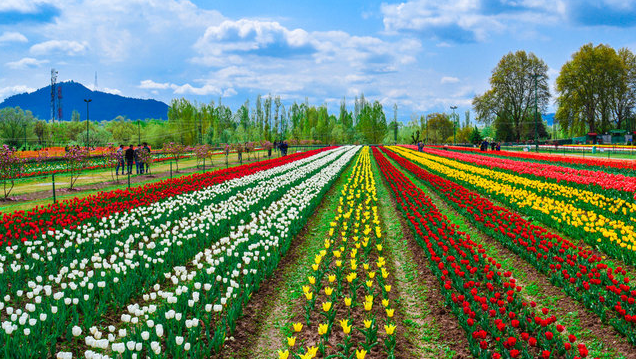As the first breath of spring sweeps across the Kashmir Valley, a silent transformation begins. The stark winter landscape gives way to a breathtaking ocean of colors, drawing visitors from across the globe. The Indira Gandhi Memorial Tulip Garden, nestled in the lap of the Zabarwan Range, stands as a testament to nature’s artistry and human perseverance. Here, against the shimmering expanse of Dal Lake, over 1.5 million tulips bloom in perfect harmony, creating an ethereal paradise that lasts only for a few fleeting weeks.
“Wuchh lalvun chhui vanas, baharuk soruyai rang wathwan”
(Behold how the wilderness blushes, spring paints every path with color)
— Rasul Mir
To the average visitor, it is a mesmerizing sight—crimson, saffron, lilac, ivory, and gold dancing under the clear Kashmiri sky. But beyond this magnificent display lies a story untold—a tale of relentless labor, unwavering dedication, and silent sacrifices. This is the story of those who toil unseen, the silent keepers of spring, who, with calloused hands and weathered faces, nurture a miracle that the world comes to admire.
“Yi gul yi gulzar, yi badam phambnar”
(These flowers, these gardens, these almond blossoms in mist)
— Habba Khatoon
Each tulip, swaying gently in the cool spring breeze, whispers a song of patience and resilience, echoing the spirit of the valley itself. The garden, a tapestry woven with hues of hope and renewal, stands as a living tribute to those who shape its fleeting splendor.
“Harud aayyi paez poshan, az gul gulzar chhavan”
(Autumn withered the flowers, but today, the garden blooms anew)
— Mahjoor
For a brief moment, the valley is wrapped in the fragrance of rebirth, an ephemeral dream where time slows, and beauty reigns supreme. But even as the petals begin to fall, leaving behind only a whisper of their former glory, the hands that shaped them remain—ready to weave yet another season of splendor.
Few people realize that the spectacle they witness in April is sown in the chill of autumn. Long before a single tulip petal unfurls, the real work begins in October, when the valley starts preparing for winter’s grip.
The gardeners, draped in phirans and woolen caps, step onto the fields with quiet determination. The ground is tough, hardened by the fading warmth of summer, and must be broken with spades and bare hands. It is not a mere act of digging—it is a precise science. The soil must be aerated to the right consistency, enriched with organic nutrients, and rid of unwanted weeds.
Then comes the delicate yet back breaking process of planting. Unlike wildflowers that scatter their seeds carelessly, tulips demand precision. Each bulb is cradled into the earth at a specific depth—not too deep to suffocate, not too shallow to be damaged by frost. The rows must be perfectly aligned, ensuring that when spring arrives, the tulips bloom in orchestrated elegance.
Hour after hour, under an amber autumn sun, these men and women kneel on the earth, burying thousands upon thousands of bulbs with their fingers stiff from the growing cold. Their labor is not romantic—it is exhausting, grueling, and unforgiving. Yet, they persevere, driven by an unseen devotion to the craft.
As snow blankets the valley, the tulip bulbs disappear beneath the frozen earth, entering their long slumber. To an outsider, the garden seems abandoned, but for the caretakers, the work is far from over.
Rodents, excessive moisture, and unexpected weather patterns pose an ever-looming threat. The gardeners and laborers visit even in the harshest cold, ensuring that the bulbs remain undisturbed, their potential for beauty intact.
The snow-covered ground holds a silent promise—a contract between the earth and those who tend to it. They know that if they have planted well, if they have protected the bulbs through the long and ruthless winter, spring will reward their patience.
As the first whispers of warmth drift into the valley in early March, something stirs beneath the soil. A green tendril pushes through the earth—a fragile, trembling thing, yet full of life. It is a moment of triumph, yet also one of immense responsibility.
Now begins a race against time. The tulip shoots must be monitored daily—too much rain and they will rot; too little and they will dry out. The fertilization schedule must be precise, the watering done with measured care. A single mistake, a single night of unexpected frost, can undo six months of relentless labor.
The entire team of caretakers knows that timing is everything. If the tulips bloom too soon, they will wither before the tourists arrive. If they bloom too late, the spirit of spring in Kashmir will pass without them.
Every morning, under the light of dawn, the workers walk through the garden, bending low to inspect each row. Their hands move swiftly—pruning, supporting, ensuring that every tulip stands tall, proud, and ready for its grand performance.
Finally, the moment arrives. By late March or early April, the tulip garden explodes into an unimaginable burst of color. The valley, which had been draped in monochrome through the winter, is now alive with shades that defy description.
Tourists pour in from every corner of India and beyond, cameras clicking, laughter ringing in the air. They walk along the garden paths, mesmerized by the view, their eyes reflecting the magic before them. Politicians and celebrities visit, social media floods with photographs, and headlines celebrate the “Asia’s Largest Tulip Garden.”
Yet, amidst all this festivity, the real heroes remain unseen. The men and women who planted each bulb, who braved the cold and the uncertainty, stand quietly in the background, watching their work bring joy to thousands.
Their satisfaction is silent. Their names will not be mentioned in the news reports. No one will ask about their cracked hands, their aching backs, or the months of labor that went into making this brief spectacle possible.
As the days pass, the tulip petals begin to curl inward, their vibrancy fading with the retreating spring. By the time May arrives, the once-flourishing garden is a memory, a canvas wiped clean.
But for the workers, the cycle does not end. Now, they must prepare for the next year. The tulips are removed, the bulbs dug up, sorted, and stored with care. The soil must be rejuvenated, enriched once more, so that when October comes, the entire process can begin anew.
The tourists leave, the garden falls silent, and Kashmir moves on. Yet, the keepers of spring remain. They do not seek applause or recognition. Their reward lies not in fame, but in the quiet knowledge that, when the world sleeps through winter, they will be the ones to weave the first colors of spring.
“Be chus wathwopdi baagwaan,
Baag yath wathwopdan chani na” — Rasul Mir
(I am but a wandering gardener,
This garden does not belong to me.)
It is easy to be mesmerized by the grandeur of tulips in full bloom, their delicate heads nodding to the whispers of the wind. The riot of colors stretching across the foothills of Zabarwan captivates the soul, tempting every traveler to believe in the effortless beauty of nature. But beneath this enchanting spectacle lies a story not often told—the story of toil, care, and silent devotion.
The tulip garden of Kashmir, Asia’s largest, does not merely bloom out of thin air. Its brilliance is born from hands that have tilled the soil through the harshness of winter, from backs that have bent under the weight of unseen burdens, from hearts that have nurtured each bulb as if tending to a newborn. These laborers, these unseen artists of nature, do not sign their names in books, yet their artistry is inscribed in every petal that unfolds.
“Yi gul yi gulistan myani,
Yi harud yemberzal myani” — Mahjoor
(These flowers, this garden is mine,
This spring, this autumn is mine.)
Every bloom carries the essence of an untold struggle—the patience of the gardener who wakes before dawn to water the saplings, the endurance of the caretaker who shields them from the unpredictable moods of weather, and the silent heroism of those who remain in the shadows, unseen and uncelebrated. Their hands, roughened by the touch of earth, write poetry not with ink but with petals; they weave dreams not with words but with colors.
Perhaps, the next time we walk through the tulip garden, we should pause—not just to admire the beauty that unfolds before us but to acknowledge the devotion that has made it possible. The tulips do not bloom for themselves; they bloom as a testament to labor, to love, to sacrifice.
“Vuchh myani haale weyi chhane saaye,
Duniya rozan gul gasan” — Rehman Rahi
(Look at my state under this shade,
The world moves on, letting flowers bloom.)
Spring in Kashmir is not merely a season; it is a revelation. It speaks of resilience, of silent perseverance, of the truth that beauty is never effortless—it is always earned. And so, as the valley bursts into bloom year after year, let us remember: spring does not arrive by magic. It arrives through sweat, through labor, through hands that remain unseen but never forgotten.
(Author is RK Columnist and can be reached at: [email protected])








